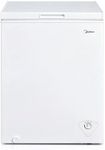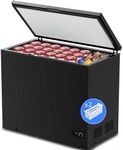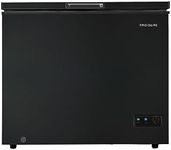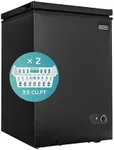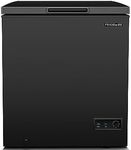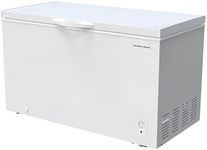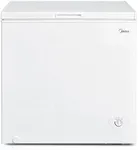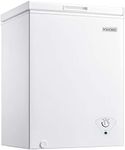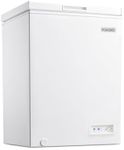Buying Guide for the Best Deep Freezers
When choosing a deep freezer, it's important to consider your storage needs, available space, and the type of food you plan to store. Deep freezers come in various sizes and configurations, and selecting the right one can help you preserve food efficiently and save money in the long run. Here are some key specifications to consider when picking a deep freezer and how to navigate them to find the best fit for you.CapacityCapacity refers to the amount of storage space inside the deep freezer, usually measured in cubic feet. This spec is important because it determines how much food you can store. If you have a large family or like to buy in bulk, you might need a larger capacity freezer. For smaller households or occasional use, a smaller capacity might suffice. Generally, deep freezers range from 5 to 25 cubic feet. Consider your shopping habits and the amount of space you have available to determine the right capacity for you.
Energy EfficiencyEnergy efficiency indicates how much electricity the deep freezer uses. This is important because it affects your utility bills and environmental impact. Look for models with an Energy Star rating, which means they meet certain energy efficiency guidelines. More efficient models will cost less to run over time. If you plan to use the freezer frequently or keep it in a warm area, investing in an energy-efficient model can save you money in the long run.
Temperature ControlTemperature control allows you to set and maintain the desired temperature inside the freezer. This is crucial for preserving the quality and safety of your food. Some models offer manual dials, while others have digital controls for more precise settings. If you store a variety of foods that require different temperatures, look for a freezer with adjustable temperature settings. For general use, a basic temperature control system may be sufficient.
Defrost TypeDefrost type refers to how the freezer manages ice buildup. There are two main types: manual defrost and automatic (frost-free) defrost. Manual defrost freezers require you to periodically turn off the freezer and remove the ice buildup, which can be time-consuming but often results in better energy efficiency. Frost-free models automatically prevent ice buildup, making them more convenient but potentially less energy-efficient. Choose based on your preference for convenience versus energy savings.
Size and DimensionsSize and dimensions refer to the physical measurements of the deep freezer. This is important to ensure the freezer fits in the space you have available. Measure the area where you plan to place the freezer, including any doorways or hallways it needs to pass through. Deep freezers come in various shapes and sizes, so you can find one that fits your space perfectly. Consider both the external dimensions and the internal storage layout to make sure it meets your needs.
Noise LevelNoise level indicates how much sound the freezer makes while operating. This is important if you plan to place the freezer in a living area or near bedrooms. Some models are designed to operate more quietly than others. If noise is a concern, look for models with a lower decibel rating. For placement in a garage or basement, noise level may be less of an issue.
Additional FeaturesAdditional features can include things like interior lighting, lockable doors, adjustable shelves, and alarms for temperature changes. These features can add convenience and functionality to your freezer. Consider which features are important to you based on how you plan to use the freezer. For example, interior lighting can be helpful if you often access the freezer in low light, while a lockable door can provide added security.
